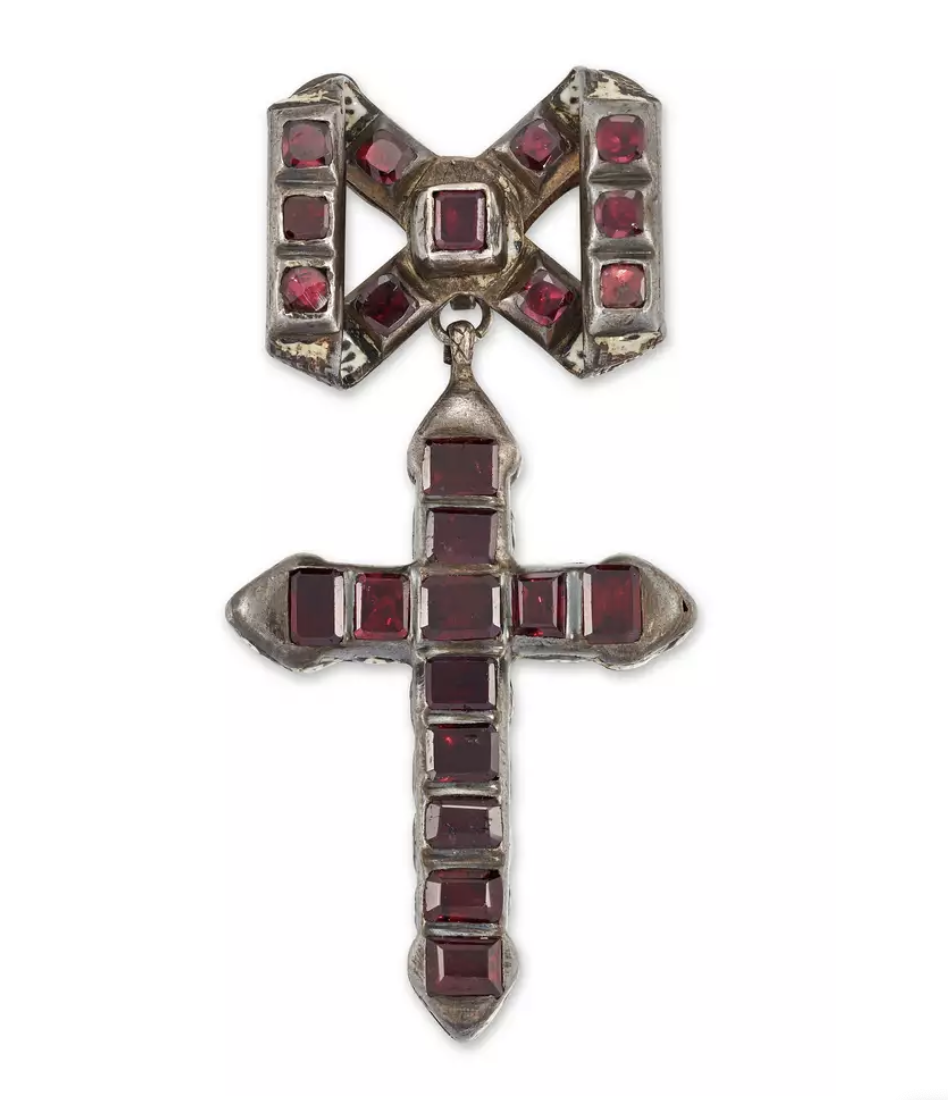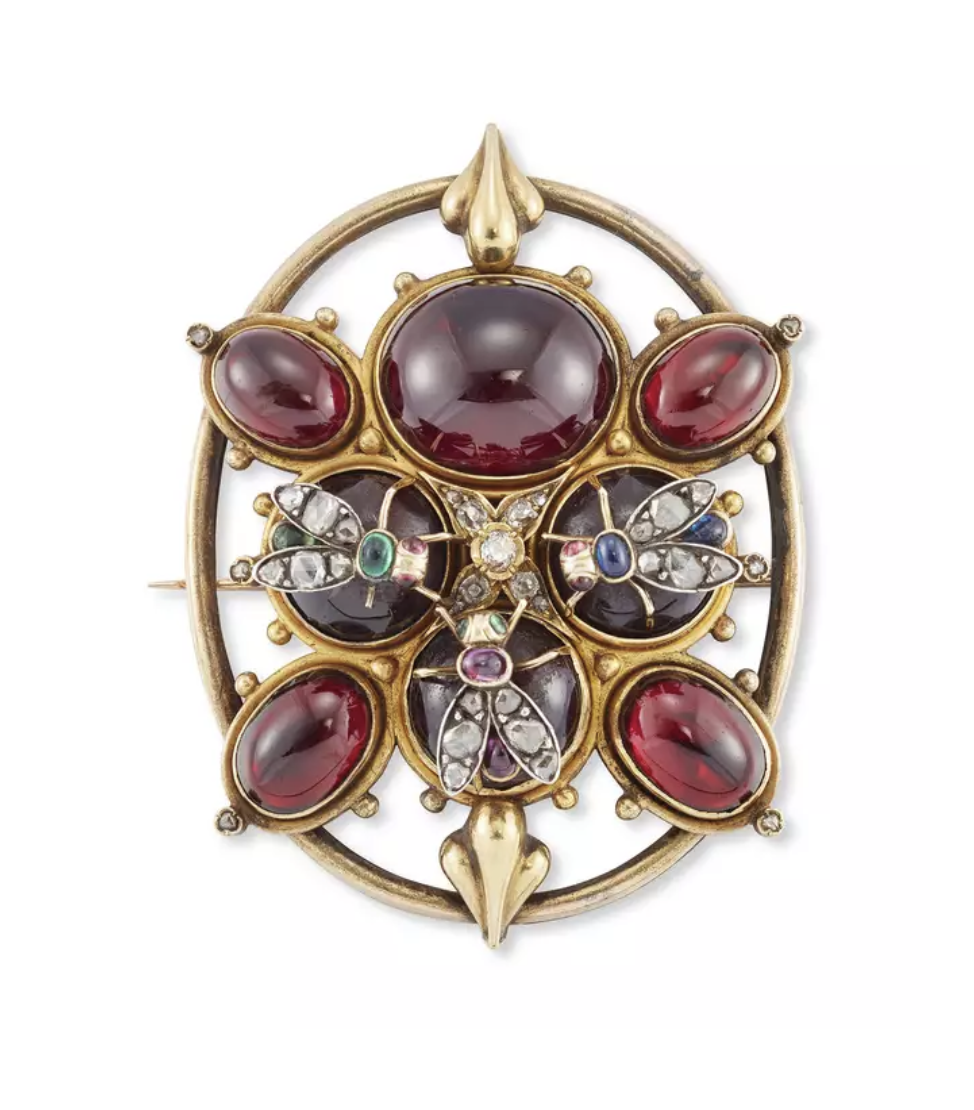Garnets have a rich and varied history dating back to the Bronze Age, though today they are often under appreciated. The word garnet is thought to derive from the Latin word ‘granatium’ meaning pomegranate. Another conception is that it derived from the Midde English word ‘gernet’ meaning dark red. The deep velvety, or blood red of Pyrope garnet was greatly sought after, with examples being recovered from the great tombs of Egypt. It was much treasured during the Middle Ages. Often mistaken for ruby the garnet was thought to ward off the plague and prevent melancholy. The Anglo Saxons mounted small slivers of Almandine garnet (the more purplish red variety) into gold ornaments and jewellery, giving a cloisonné appearance. These garnets were mined in the central mountains of Bohemia (now the Czech Republic) where they can still be acquired today. These were referred to as Bohemian garnets.
Lot 3: A 17th century silver garnet cross pendant
Evolution of Styles and Settings
The pyrope and almandine garnet where the most prolifically used in jewellery and the cutting style of cabochon (domed) was very popular as it was simple and easy to cut and also accentuated the red colour of the stone. Garnets were often set singly in gold ring bezels and worn by those of high rank from the Roman period to the 17th century. During the late 18th century a technique of foiling gemstones came into vogue. This method involved mounting a thin flat-cut garnet into a bowl shaped mount that was lined with coloured metal foil. This added to the colour and in addition meant that each mount could be matched when put together as a necklace. This type of jewellery was produced in quite large numbers as demand was high. There is a story that in Revolutionary France wives of officials wore a single row tightly around the neck imitating a bloody line in order to provoke aristocrats who might shortly face the guillotine! Garnets also saw use in many religious jewels and there are many surviving examples of Iberian jewellery of the 18th to 19th century.
The Victorian taste for archaeological jewellery saw a variety of large impressive jewellery that imitated the styles of the ancients. These proved a perfect vehicle for the setting of large red cabochon garnets, reviving the term ‘carbuncles’. Not to be confused with the medical term, the term carbuncle garnet originates from medieval texts describing the magical and physical attributes of the stone. Milton describes in ‘Paradise Lost’ that Satan’s eyes were like carbuncles.
Lot 30: A Victorian gold garnet brooch
Beyond the Red Spectrum
Whilst red is the colour most commonly associated with garnets, there are also a number of other varieties of garnet found in other colours. One of the most prized varieties of garnet is the demantoid garnet which comes in bright shades of green to yellow-green and is esteemed for its high dispersion (or fire) and lustre. In fact, the name is derived from the old German ‘demant’, meaning diamond like, in reference to demantoid’s adamantine lustre and exceptional fire, which is actually even higher than that of diamond. Demantoid garnet was first discovered in 1849, and the original source was the Ural mountains in Russia. As might be expected, demantoid was a firm favourite amongst the Tsar’s court jewellers, but it also become a mainstay in high-end late Victorian and Edwardian jewellery. One of the distinctive features of demantoid are the ‘horsetail’ shaped inclusions that can be found in some stones. These inclusions are made of fine chrysotile needles, and whilst the general rule with gemstones is that the fewer inclusions the better, a very finely formed and well positioned horsetail inclusion can add to the value of a demantoid garnet.
Another green variety is tsavorite garnet, discovered in the 1960s, with deposits known in Kenya, Tanzania and Madagascar, whilst orange varieties include spessartite garnet and hessonite garnet.






